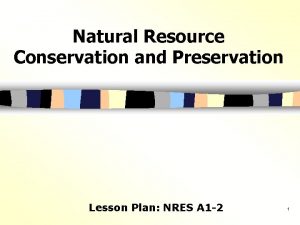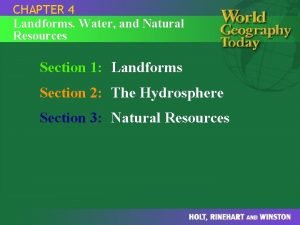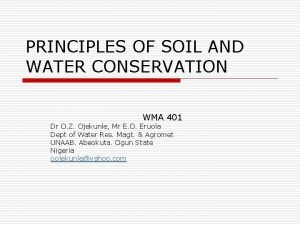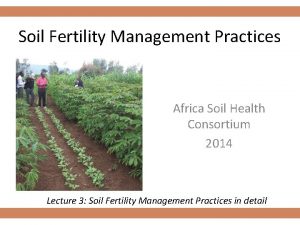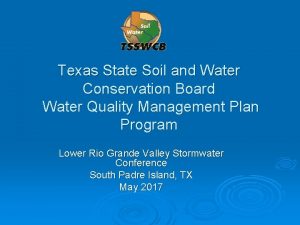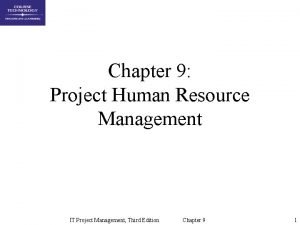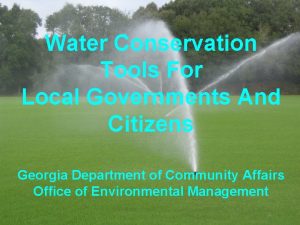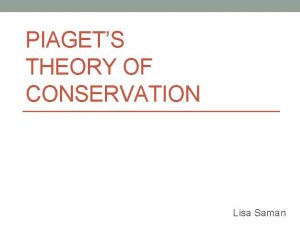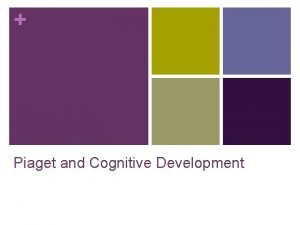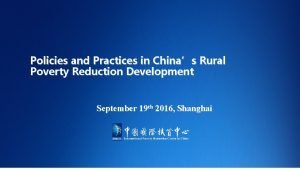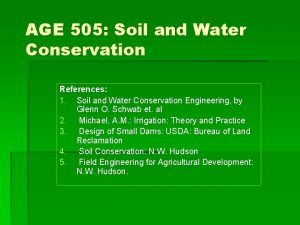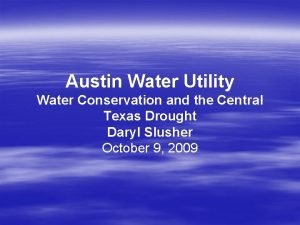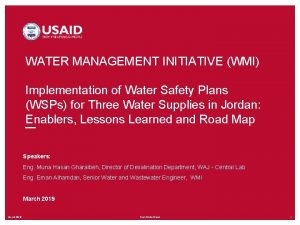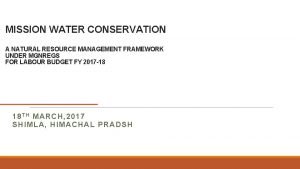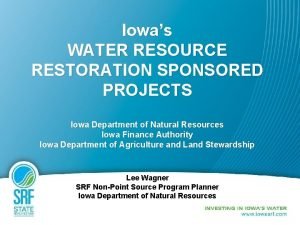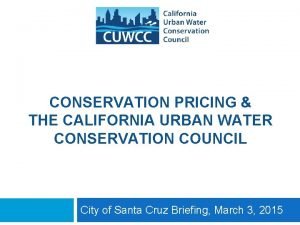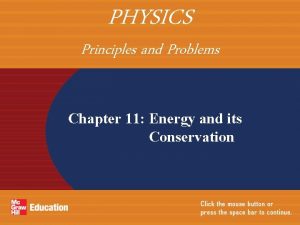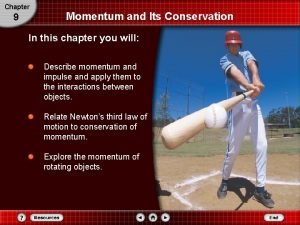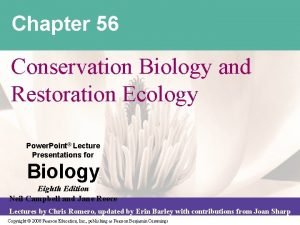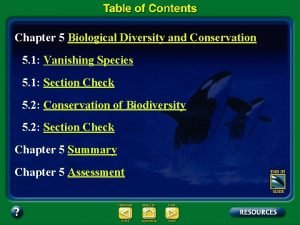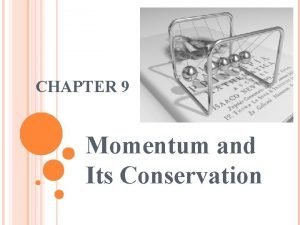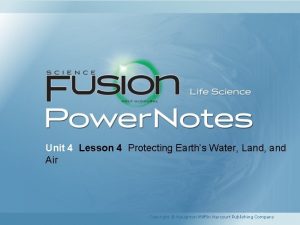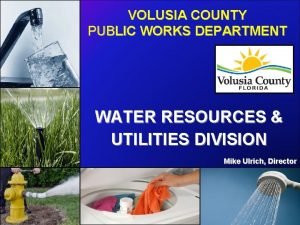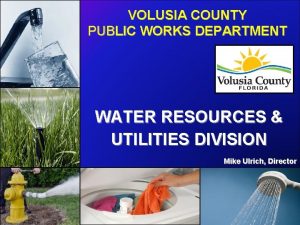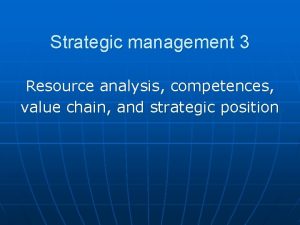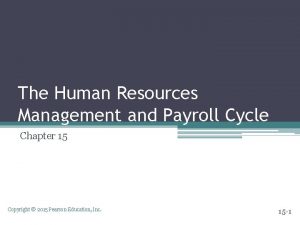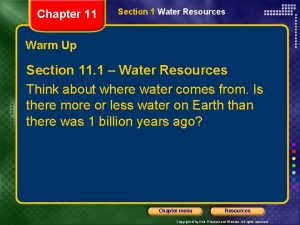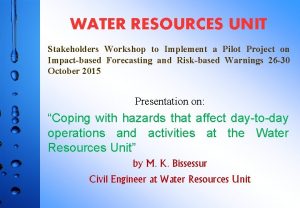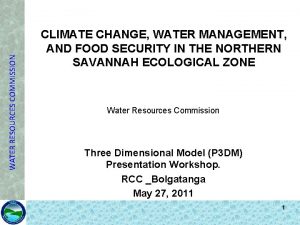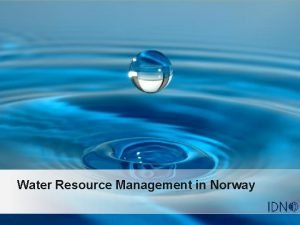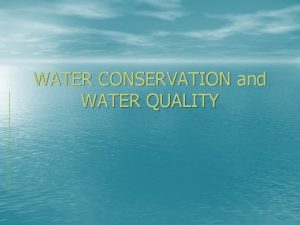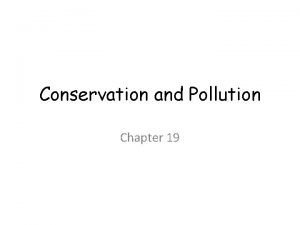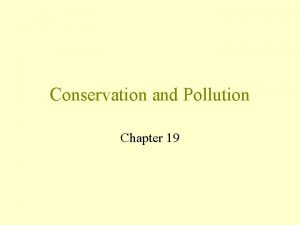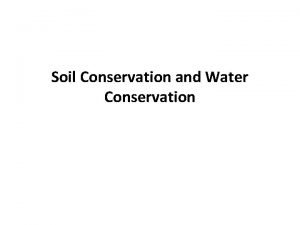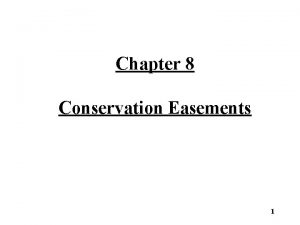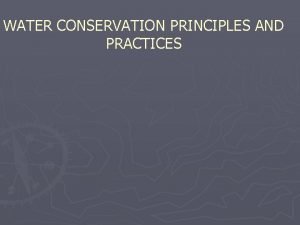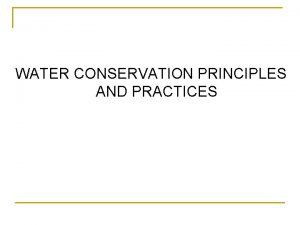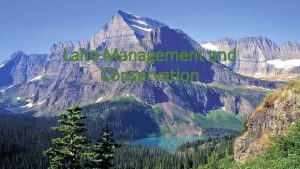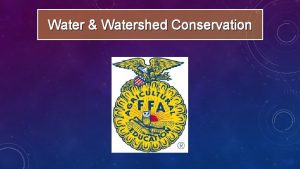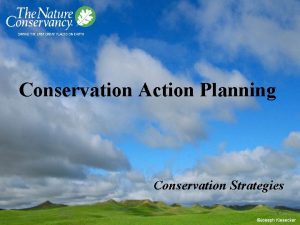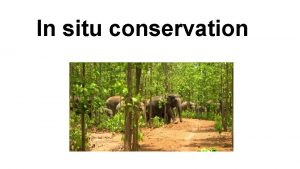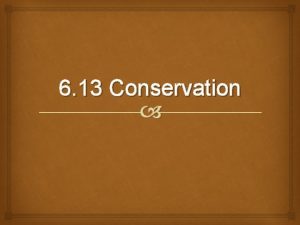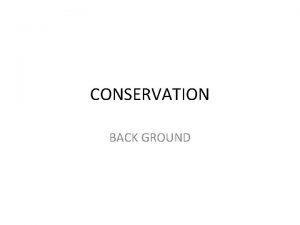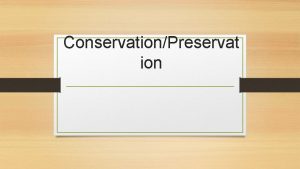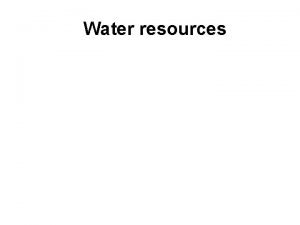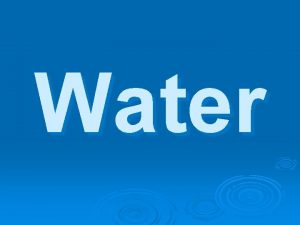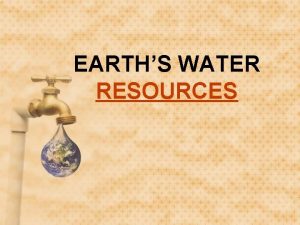Chapter 11 Water resources management and conservation Water

















































- Slides: 49

Chapter 11 Water resources, management and conservation

�Water is essential to life on Earth. Most of the water we drink has been around since Earth’s beginnings 4. 6 billion years ago �Humans can only live approximately 3 days without water but we can go for about a month without food.

� 2 kinds of water: �Fresh water – contains little salt. Glaciers, lakes �Salt water – contains higher concentrations of salt ≈ 35 ppt like in the oceans

�On Earth, water exists in 3 phases – solid, liquid and gas and is a renewable resource because it is circulated in the water cycle – where water molecules travel between the Earth’s surface and the atmosphere


Global Water Distribution � 71% of Earth’s surface is covered with water however 97% is salt water � 3% is fresh water which comes from lakes and rivers which are called surface water – the rest comes from ground water – which is beneath the Earth’s surface in sediment and rock formations


�Surface water �Rivers, lakes and streams provide drinking water, water to grow crops, food like fish and shellfish, power for industry and transportation by boat

�River systems �Falling rain forms streams as well as snow melts flow downhill and combine with other streams to form rivers – as they move across land they form a flowing network of water = river systems

�Watersheds �The area of land that is drained by a river � Ex. Mississippi Watershed �If we have large amounts of snow in Canada or northern states – we could flood in Louisiana �If pollution gets in a stream anywhere in the watershed, it will pollute the river


Ground Water �Available fresh water that exists underground – water from rain percolates through soil and down into rocks beneath the surface

�Aquifers – an underground formation that contains ground water � Ex. Ogallala Aquifer pg. 292 -293 – formed from melting glaciers at the end of the last ice age ≈ 12, 000 years ago

�Recharge zones – surface water mush travel down through permeable layers of soil and rock to reach an aquifer – if surface water percolates down into an aquifer it is called a recharge zone � Sensitive areas to pollution

�Wells – are dug to reach ground water. If ground water is removed faster than it is recharged – the water table falls below the bottom of the well and the well must be dug or drilled deeper

Water Use and Management �A shortage of enough fresh water is one of the world’s most pressing environmental problems because of the increasing number of people who rely on Earth’s limited freshwater reserves �According to the World Health Organization – more than 1 billion people lack access to a clean, reliable source of fresh water

Global Water Use � 3 major uses for water – residential, agricultural and industrial �The availability of fresh water, population sizes and economic conditions affect how people use water �Only about 8%, globally, of water is used by households for drinking and washing

Residential Water Use �The average person in the US uses about 80 gallons of water each day – in other countries like India they use roughly ½ that amount �In the US about ½ that amount is used inside the home. The rest is used outside the home

Water Treatment � Most water must be treated to be potable, or safe to drink �Treatment removes elements like mercury, arsenic and lead. It also removes pathogens – such as bacteria, viruses or disease – pathogens contaminate water by sewage or animal feces �Water is filtered and chlorinated to prevent bacteria growth �Other elements are added in some communities like fluoride – to prevent tooth decay or sodium or lime to soften hard water


Industrial Water Use �Accounts for 19% of water use in the world �Used to manufacture goods, dispose of waste or to generate power �Most of the water used in industry is used to cool power plants

Agricultural Water Use �Accounts for 67% of water use in the world. It takes nearly 80 gallons of water to produce 1 ear of corn �Irrigation – a method of providing plants with water from sources other than direct precipitation. Only used when rainfall is inadequate


Water Management Projects �Even 2000 years ago – Romans built aqueducts which brought water from the mountains to dry areas of France and Spain �Because people often live in areas where the natural distribution of surface water is inadequate- water management projects such as dams and water diversion canals must be used �Water diversion projects – all or part of a river is diverted into canals which carry water for drinking water or other residential use


Dams and reservoirs �Dam – a structure build across a river to control the river’s flow. When a river is dammed an artificial lake or reservoir is formed �Can be used for flood control, drinking water, irrigation, recreation and industry �Hydroelectric dams use the power of flowing water to generate electrical energy – supplies about 20% of the world’s electrical energy. �Problems with dams – fertile sediment builds up behind dam and doesn’t enrich soil down river


Water Conservation �Households use much less water than agriculture or industry �Water-saving technology – low flow toilets and shower heads �About 1/3 of the water used by average households in the US is used for landscaping �Water lawns at night to reduce the rate of evaporation


Solutions for the future �In some places water conservation alone is not enough to prevent water shortages � 2 possible solutions are desalination or transporting fresh water �Desalination – process of removing salt from salt water � Middle East – heat salt water and collect the fresh water that evaporates �Transport Water – because about 77% of Earth’s freshwater is frozen in ice caps the US is looking into shipping freshwater


Water Pollution �The introduction of chemical, physical or biological agents into water it degrades water quality and negatively affects organisms that depend on water � 2 underlying causes: � Industrialization � Rapid human population growth


�Even though developed countries have cleaned up water supplies in the last 30 years, we still have dangerously polluted water in the US

�To prevent water pollution, we must understand where pollutants come from � 2 types of sources of water pollution: � Point-source pollution – factories, wastewater treatment plants, leaking oil tankers � Pollution is discharged from a single source � It can be identified and traced to a source � Non point-source pollution – rain runoff from farms with animal waste and pesticides, runoff from roads, oil spills, chemicals added to roads for deicing, etc. � Extremely difficult to control – 96% of the polluted bodies of water in the US were contaminated from non point sources � To control this type of pollution depends on public awareness of the effects of their activities – dispose of oil in storm drains, animal feces in yards or farms

Point Source Pollution

Principal Water Pollutants �Pathogens – from sewage or farms �Organic matter – food waste, animal and plant matter remains �Organic chemicals – pesticides, fertilizers, gas and oil �Inorganic chemicals – acids, bases, salts from industrial waste and roadways �Heavy metals – Pb, Hg, Cd, As from household chemicals and landfills �Physical agents – soil erosion

�Wastewater – water that contains waste from homes or industry �At a treatment plant water is filtered and treated to make it clean enough to return to a river or lake �Treating wastewater � Most wastewater from homes contain biodegradable material that can be broken down by living organisms � Some wastewater however contains toxic substances which must be treated different ways �Sewage sludge – the solid material that remains after water treatment. Sometimes it contains toxic materials, usually from industry and it must be disposed of as hazardous waste – it is incinerated and the ash is buried in a landfill �Can be used as fertilizer or combined with clay to make bricks for buildings


Sewage Sludge

Artificial Eutrophication �Most nutrients in water come from organic matter, like leaves and animals waste which is broken down into mineral nutrients by decomposers – bacteria and fungi �Nutrients are important to ecosystems but an overload of nutrients can disrupt ecosystems – when aquatic ecosystems contain an abundance of nutrients they are eutrophic �Eutrophication – is a natural process – the process of decomposition of organic matter uses up oxygen. When O 2 levels decrease the types of organisms that live in the water change over time – plants take root in the nutrient rich sediment at the bottom eventually changing the body of water into a swamp or marsh


�Artificial eutrophication – when the natural process of eutrophication is accelerated when inorganic nutrients such as phosphorous and nitrogen enter the water from sewage and fertilizer runoff from farms, lawns and gardens. Phosphates in laundry and dishwashing detergents are another major cause of artificial eutrophication. Phosphates can lead to algae blooms – as the algae die and decompose most of the dissolved oxygen in the water is used up creating oxygen-depleted or hypoxic water causing fish and other organisms to suffocate


Thermal pollution �When the temperature of a body of water increases usually caused by power plants discharging warm water from their cooling systems into a lake or stream �It can cause large fish kills because the amount of oxygen the water can hold decreases when temperature goes up. Fish suffocate and die in these hypoxic conditions

Groundwater pollution �Pesticides, herbicides, fertilizers and petroleum products from the surface percolate down with rain water into the ground water

Ocean pollution �Ships can dump, legally, wastewater and garbage overboard in some parts of the ocean – but 85% of ocean pollution comes from activities on land including oil pollutants, toxic waste and medical waste – most occurs near coastlines

Water Pollution and Ecosystems �Pesticides can build up in the bodies of organisms leading to biomagnification – the accumulation of pollutants at successive levels of the food chain � Ex. DDT �Pesticides enter the bodies of small crustaceans or zooplankton which are eaten by small fish which are eaten by bigger fish which is then eaten by predatory birds like eagles – the pesticides are stored in the tissues and the concentration of these pesticides goes up at each level of the food chain

 Water and water and water water
Water and water and water water Lesson plan on conservation of natural resources
Lesson plan on conservation of natural resources What is the transformative process of operations management
What is the transformative process of operations management Fixed resources
Fixed resources Chapter 4 landforms water and natural resources
Chapter 4 landforms water and natural resources Water conservation objectives
Water conservation objectives Africa soil health consortium
Africa soil health consortium Texas state soil and water conservation board
Texas state soil and water conservation board Renewable vs nonrenewable resources worksheet
Renewable vs nonrenewable resources worksheet Chapter 14 water resources
Chapter 14 water resources Chapter 11 section 1: water resources answers
Chapter 11 section 1: water resources answers Environment management tools
Environment management tools Chapter 9 human resource management
Chapter 9 human resource management Intro to human resource management
Intro to human resource management Chapter 9 human resources management
Chapter 9 human resources management Water conservation tools
Water conservation tools Jean piaget conservation
Jean piaget conservation Piaget's water conservation task
Piaget's water conservation task Piaget 4 stages
Piaget 4 stages Water conservation project
Water conservation project Water conservation references
Water conservation references Water conservation in hotel industry
Water conservation in hotel industry Austin water rebates
Austin water rebates Water conservation project
Water conservation project Mission water conservation under mgnrega
Mission water conservation under mgnrega Water conservation project
Water conservation project California urban water conservation council
California urban water conservation council Chapter 11 energy and its conservation study guide answers
Chapter 11 energy and its conservation study guide answers Momentum and its conservation chapter 9
Momentum and its conservation chapter 9 Chapter 56 conservation biology and restoration ecology
Chapter 56 conservation biology and restoration ecology Chapter 5 biological diversity and conservation
Chapter 5 biological diversity and conservation Chapter 11 energy and its conservation answers
Chapter 11 energy and its conservation answers A 1875 kg car going 23 m/s
A 1875 kg car going 23 m/s Which is represented by the equation fδt = pf - pi ?
Which is represented by the equation fδt = pf - pi ? Chapter 5 biodiversity and conservation answer key
Chapter 5 biodiversity and conservation answer key Chapter 5 section 1 biodiversity
Chapter 5 section 1 biodiversity Air and water resources lesson 4
Air and water resources lesson 4 Volusia county utilities
Volusia county utilities Volusia county utilities
Volusia county utilities Operations management chapter 10
Operations management chapter 10 Question paper of hrm
Question paper of hrm Human resource audit
Human resource audit Payroll cycle activities
Payroll cycle activities Chapter 7 energy conservation of energy
Chapter 7 energy conservation of energy Chapter 11 section 3 water pollution answer key
Chapter 11 section 3 water pollution answer key Water resources unit
Water resources unit Conclusion on water resources
Conclusion on water resources Norway water resources
Norway water resources Sabah water resources enactment 1998
Sabah water resources enactment 1998 Importance of water resource management
Importance of water resource management

